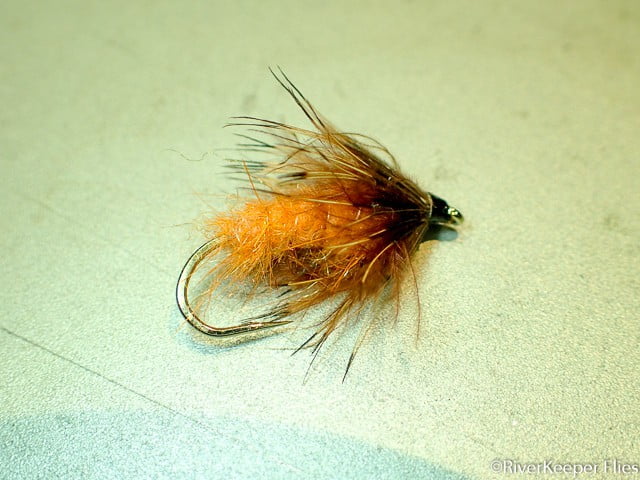I can’t believe it’s almost October! I haven’t been to the river in a while because of all the smoke and closures, but would expect to see October Caddis flitting around the water and laying eggs. Fishing October Caddis flies can be exciting this time of year.

Here is a post from last year I hope you find informative.
October Caddis time begins in September and October. In fact, I’ve seen several flitting around lately and thought it might be a good time to provide an update to the blog post I wrote in previous years. You’ll see these size 10 – 8 bugs around the vegetation and over water. They are a large, tasty meal for Mr. Trout.
October Caddis can be seen on my home waters, the Metolius River, in other months as well. I’ve seen a similar looking bug, the Silver Striped Sedge, in the months of January through April.

Much of the following information is taken from earlier RiverKeeper Flies posts.
The October Caddis (Dicosmoecus), otherwise known as the Giant Orange Sedge, hatches in September and October. These bugs are too big for the fish to ignore.

Most of a caddis’ life is spent in the larval stage inside a case, which they build from small rocks found on the stream bed. Prior to hatching, you’ll find these bugs crawling to the edge of riffles and runs, dragging their cases with them. They seal off the case opening and pupate to their next phase of life. When the time is right, the pupae climbs out of the case and swim to the surface or crawl out on a log or rock and transition the final time to an adult. The back of the pupae opens and out crawls a winged adult. (For some spectacular pictures of this transition, check out Arlen Thomason’s great book entitled Bug Waters). Generally, this transition from an aquatic insect to an adult can be a terrific time to fish a caddis hatch. But the October Caddis hatch isn’t one of them. They are known to hatch at night when it’s illegal for us to fish.
While on the river a couple of years ago, I took several photos of October Caddis still in their cases.
I was fishing and looked down to see a large number of caddis cases … big caddis cases … attached to a rock partially submerged in the water. It looked as though someone had collected all of them and left the cases in a pile. Upon closer inspection, the caddis cases were attached to the rocks.

Here is a closeup of the cased caddis. They build their houses out of the surrounding rocks where they live.

I pried one off and found the opening closed. What did that mean? I tore into one of the cases and found an October Caddis in its final stage of transforming from a larva into a pupa stage, preparing to swim to the surface and fly away as an adult.

Pulling away more rocks from the stone house, the pupa becomes more visible.

October Caddis are in the final transitional stage of life as it changes from the larva to a pupa. It’s a similar process of a caterpillar enclosed in a cocoon, developing into a butterfly. I’ve read where this process can take up to two months.

While you won’t see October Caddis pupa swimming to the surface, the Morrish October Caddis Pupa still seems to catch fish. I’m guessing the fish are used to seeing this mouthful and anxiously take the fly. You can always use it with a smaller nymph to search for trout.
A customer contacted me this year to see if I could tie up a few new-to-me October Caddis pupa flies. It was called the Miasmic October Caddis Pupa-Emerger. I’ve recently added it to my fly pattern sheets.
Here is the dry version…

…and what it looks like when wet…

My other favorite nymph pattern is the Morrish Deep October Caddis.

As an extra bonus, steelhead have been known to rise for an October Caddis pattern. How exciting would that be?
October Caddis are available to trout as a dry fly at three key times – just after hatching, during windy days, and when females lay their eggs.
Be sure to try an October Caddis dry fly along the bank in 2 to 4 feet of water with overhanging grasses, trees, or other vegetation. This is a likely spot for trout to hang out and grab a bug or two.
I enjoy blind-casting a dry fly and I’ve had good luck with the Morrish October Caddis or my own RiverKeeper October Caddis.
You’ll find an occasional fish come up hard and take this size 8 fly.

But you better be ready! Begin now preparing for October Caddis. Check your fly box and make sure you have a few flies to match the hatch.
Enjoy…go fish!









I am aged and new to fly fishing and fly tying but not new to either. That being said, I tied flies and fly fished in the 60’s and 70’s and quit. I lake bass fished the 80’s and 90’s and quit 2006. Jump ahead to 2017 started bass fishing once again and started fly fishing and tying 2024. I am amazed at all your October Caddis pattern’s and look forward to tying them and fishing them in the next week. Thank you for such a great read and patterns.